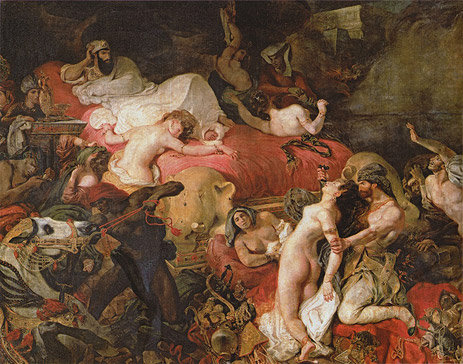Image Resource Bank
Image Gallery |  14 of 15
14 of 15 
Orientalism: Assyrian Fantasy
In “The Death of Sardanapalus,” Delacroix turned the vision of Romantic Orientalist art on ancient Assyria before Europeans began to rediscover the reality of ancient Assyria. His painting was based on a play by the Romantic poet Byron, which was based in turn on a fragment of the ancient Greek historian Ctesias (ca. 400 BCE). The Romantic composer Hector Berlioz also wrote a cantata on the subject, now lost. Delacroix’s work exemplifies the dramatic lighting, color, and turmoil of Romantic art, as well as the combination of sex, violence, luxury, and despotism that characterized Romantic Orientalism.
Ctesias’ tale of the Assyrian king Sardanapalus, who commited suicide amid his riches by burning his own palace, may conflate misunderstood echoes of two historical Assyrian rulers. Contemporaries of Byron and Delacroix could not have known that, but they understood very well that this was no historical account, not for Ctesias and not for them; it was a fable about unbalanced power and wealth leading to debauchery, effeminacy, weakness, and destruction.
Delacroix had no authentic models to draw from, so the scene is an Oriental hodge-podge, with architecture reminiscent of ancient Egyptian monuments and servants in costumes reminiscent of Ottoman courtiers.
Name: The Death of Sardanapalus
Material: Oil on Canvas
Size:
Height: 3.92 m (12 ft 1 in)
Width: 4.96 m (16 ft 3in)
Date: ca. 1827-1828 CE
Place of Origin: Eugène Delacroix
Location: Musée de Louvre, Paris, France
Source and Registration#: Wikipedia. Link to resource![]() (accessed September 10, 2009).
(accessed September 10, 2009).

 Matthew W. Stolper
Matthew W. Stolper
Professor of Assyriology and the John A. Wilson Professor of Oriental Studies




